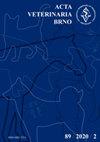妊娠母马血清抗勒氏激素(AMH)和马绒毛膜促性腺激素(eCG)浓度与胎儿性别的关系
IF 0.7
4区 农林科学
Q3 VETERINARY SCIENCES
引用次数: 0
摘要
本研究的目的是探讨妊娠阿拉伯母马不同时间点母体血清抗本文章由计算机程序翻译,如有差异,请以英文原文为准。
Evaluation of serum anti-Müllerian hormone (AMH) and equine chorionic gonadotrophin (eCG) concentrations in pregnant mares in relation to foetal sex
The aim of this study was to investigate the foetal sex related difference and progression in maternal serum anti-Müllerian hormone (AMH) and equine chorionic gonadotrophin (eCG) concentrations during different points of time in pregnant Arabian mares. The study groups formed by 12 healthy male offspring- and 12 healthy female offspring-foaling mares, designated as group MFM and group FFM, respectively. Peripheral blood samples were collected on the day of natural mating and then monthly until the 6th month (mo) of gestation. Serum AMH was measured in all serum samples; eCG was measured in samples collected from 2 to 5 months Of gestation. Serum AMH concentrations of group FFM at mo 4 and mo 5 (3.89 ± 0.49 ng/ml; 2.89 ± 0.32 ng/ml), were significantly higher than in group MFM (2.11 ± 0.46 ng/ml; 1.87 ± 0.32 ng/ml), (P < 0.05). The mo of gestation (mo 1–6) had no effect on serum AMH concentrations of either group MMF or FFM (P > 0.05). Serum eCG concentrations of group FFM at mo 2 (359.73 ± 41.51 mIU/ml), were significantly higher than in group MFM (255 ± 21.18 mIU/ml) (P < 0.05). Group-time interaction for eCG concentrations at mo 2–4 was non-significant (P > 0.05). Concentrations of serum AMH showed no relationship with corresponding eCG levels at mo 2–4 (P > 0.05). Individual variations in AMH and eCG concentrations and the inability to determine a cut-off point for determination of foetal sex make these hormones unlikely candidates for determining foetal sex in the mare.
求助全文
通过发布文献求助,成功后即可免费获取论文全文。
去求助
来源期刊

Acta Veterinaria Brno
农林科学-兽医学
CiteScore
1.00
自引率
33.30%
发文量
36
审稿时长
18-36 weeks
期刊介绍:
ACTA VETERINARIA BRNO is a scientific journal of the University of Veterinary and Pharmaceutical Sciences in Brno, Czech Republic.
The scientific journal Acta Veterinaria Brno is dedicated to the publication of original research findings and clinical observations in veterinary and biomedical sciences. Original scientific research articles reporting new and substantial contribution to veterinary science and original methods that have not been submitted for publication elsewhere are considered for publication. A written statement to this effect should accompany the manuscript, along with approval for publication by the author´s head of department. The authors bear full responsibility for the contents of their contribution. Book reviews are published, too.
 求助内容:
求助内容: 应助结果提醒方式:
应助结果提醒方式:


